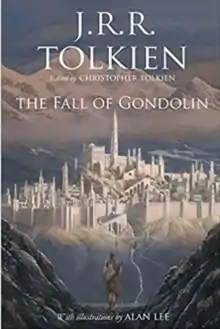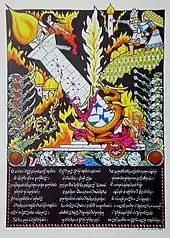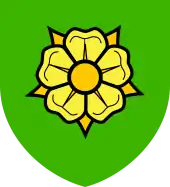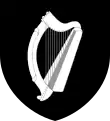The Fall of Gondolin
J. R. R. Tolkien's The Fall of Gondolin is one of the stories in The Book of Lost Tales which formed the basis for a section in his later work, The Silmarillion. A stand-alone, book-length version of the story was published in 2018.[1][2] The Fall of Gondolin is one of three stories from the First Age of Middle-earth to be published as a stand-alone book: the other two are Beren and Lúthien and The Children of Húrin.
 Front cover of the 2018 hardback edition | |
| Editor | Christopher Tolkien |
|---|---|
| Author | J. R. R. Tolkien |
| Illustrator | Alan Lee |
| Cover artist | Alan Lee |
| Country | United Kingdom |
| Language | English |
| Subject | Tolkien's legendarium |
| Genre | High fantasy |
| Published | 30 August 2018 (Worldwide) |
| Publisher | HarperCollins Houghton Mifflin Harcourt |
| Media type | Print (hardback) |
| Pages | 304[1] |
| ISBN | 978-0008302757 |
| Preceded by | Beren and Lúthien |

Story
Gondolin was a secret city of Elves in the First Age of Middle-earth. The Fall of Gondolin tells of the founding of the city; of the arrival there of Tuor, a prince of Men; of the betrayal of the city to Morgoth by the king's nephew, Maeglin; and of its subsequent catastrophic destruction by Morgoth's armies. It also relates the flight of the fugitives to the Havens of Sirion, the wedding of Tuor and Idril Celebrindal, as well as the childhood of their son Eärendil.
Gondolin
Gondolin[T 1] was founded with divine inspiration. It was hidden by mountains and endured for centuries before being betrayed and destroyed. It was the mightiest of the elven homes in the Hither Lands.[T 2] The city was famed for its walls, and had possible parallels to Troy.[3]
Gondolin was founded by King Turgon in the First Age. It was originally named 'Ondolindë'. According to The Silmarillion, the Vala Ulmo, the Lord of Waters, revealed the location of the Vale of Tumladen to Turgon in a dream. Under this divine guidance, Turgon travelled from his kingdom in Nevrast and found the vale. Within the Echoriath, the Encircling Mountains, lay a round level plain with sheer walls on all sides and a ravine and tunnel leading out to the southwest known as the Hidden Way. In the middle of the vale there was a steep hill which was called Amon Gwareth, the "Hill of Watch". There Turgon decided to found a city, designed after the city of Tirion in Valinor that the Noldor had left.
Turgon and his people built Gondolin in secret. After it was completed, he took with him to dwell in the hidden city his entire people in Nevrast—almost a third of the Noldor of Fingolfin's House—as well as nearly three quarters of the northern Sindar.
The seven gates of the city
The Hidden Pass was protected by seven gates, all constantly guarded; the first of wood, then stone, bronze, iron, silver, gold, and steel, perhaps based on Herodotus's description of the Medean city of Ecbatana. The seven gates of Minas Tirith echoed this notion of a layered defence on a hill.
The fall of the city
The city stood for nearly 400 years until it was betrayed to Morgoth by Maeglin, Turgon's nephew. Maeglin was captured while mining outside the Encircling Mountains against Turgon's orders. Maeglin betrayed the location of Gondolin after he is promised Lordship as well as Turgon's daughter Idril, who is long coveted by Maeglin. Morgoth then sent an army over the Crissaegrim, the northernmost precipitous and dangerous portion of the Encircling Mountains, during The Gates of Summer (a great Gondolin festival), catching them unawares and sacking the city with relative ease. In addition to orcs, Balrogs and dragons, Melkor's (Morgoth's) army, in early versions of the story, included iron machines (tanks) powered by "internal fires" and used as personnel carriers, to surmount difficult geographic obstacles and to defeat fortifications. Idril, noted for her intuition, had the foresight to prepare a secret route out of Gondolin prior to the siege.[4] While her father Turgon perished, Idril successfully flees the city alongside her husband Tuor and other survivors; through their union, Idril and Tuor are the ancestors of both Elrond and Aragorn.[5]
The seven names of Gondolin
According to The Book of Lost Tales, the city had seven names: "’Tis said and ’tis sung: Gondobar am I called and Gondothlimbar, City of Stone and City of the Dwellers in Stone; Gondolin the Stone of Song and Gwarestrin am I named, the Tower of the Guard, Gar Thurion or the Secret Place, for I am hidden from the eyes of Melko; but they who love me most greatly call me Loth, for like a flower am I, even Lothengriol the flower that blooms on the plain."[T 3]
The Houses of Gondolin
According to The Book of Lost Tales the active male Elves of Gondolin belonged to one of the 11 "Houses" or Thlim plus the bodyguard of Tuor which was accounted the twelfth:
| Name in Gnomish of the Houses[T 4] | Leader | Uniforms and emblems | Notes | |
|---|---|---|---|---|
| The folk of the White Wing | Tuor |  | "These wore wings as it were of swans or gulls upon their helms, and the emblem of the White Wing was upon their shields."[T 5] | The bodyguard of Tuor.[T 6] |
| The House of the Mole or the Thlim Doldrin | Maeglin |  | "Sable was their harness, and they bore no sign or emblem, but their round caps of steel were covered with moleskin."[T 5] | Composed of skilled miners. |
| The House of the Swallow or the Thlim Duilin | Duilin |  | "[They] bore a fan of feathers on their helms, and they were arrayed in white and dark blue and in purple and black and showed an arrowhead on their shield."[T 7] | Gondolin's best archers. |
| The House of the Heavenly Arch or the Thlim Quing Ilon | Egalmoth |  | "They were arrayed in a glory of colours, and their arms were set with jewels. Every shield of that battalion was of the blue of the heavens."[T 6] | A very wealthy house; comprised the other part of Gondolin's archers. |
| The House of the Pillar or the Thlim Climbol | Penlod |  | unknown | Their leader was slain during the Fall of Gondolin. |
| The House of the Tower of Snow or the Thlim Ith Mindon | Penlod |  | unknown | Their leader was slain during the Fall of Gondolin. |
| The House of the Tree or the Thlim Galdon | Galdor |  | "Their raiment was green."[T 7] | Wielded clubs and slings. |
| The House of the Golden Flower or the Thlim Losglóriol | Glorfindel |  | "[They] bore a golden flower upon their shield."[T 7] | |
| The House of the Fountain or the Thlim Ecthel | Ecthelion |  | "Silver and diamonds was their delight ; and swords very long and bright and pale did they wield."[T 7] | The guard of the fountains, primarily those of the king. Warriors of this house defended the seventh gate of Gondolin. They marched into battle to the playing of flutes. |
| The House of the Harp or the Thlim Salum | Salgant |  | "A harp of silver shone in their blazonry upon a field of black."[T 7] | House of musicians. However, their leader was a craven. |
| The House of the Hammer of Wrath or the Thlim Gothodrum | Rog |  | "The sign of this people was the Stricken Anvil, and a hammer that smiteth sparks about it was set on their shields."[T 6] | The largest and most valiant house. They comprised those blacksmiths who were not under Maeglin, as well as escaped thralls of Morgoth. They perished to the last elf during the Fall of Gondolin. |
| The House of the King | King Turgon |  | "The array of the house of the king and their colours were white and gold and red, and their emblems the moon and the sun and the scarlet heart [of Finwë Nólemë]."[T 7] | The three Royal Guard battalions of King Turgon. |
The tongue of Gondolin
In the hidden city of Gondolin, an isolated land, a peculiar Elvish dialect developed: "This differed from the standard (of Doriath) (a) in having Western and some Northern elements, and (b) in incorporating a good many Noldorin-Quenya words in more or less Sindarized forms. Thus the city was usually called Gondolin (from Q. Ondolin(dë)) with simple replacement of g-, not Goenlin or Goenglin [as it would have been in standard Sindarin]".[T 8] The common or standard Sindarin tongue was not used in Gondolin.
Weaponry
The smiths of Gondolin, using Elven craft, made powerful weapons. In The Hobbit, the swords Orcrist, Glamdring and a long dagger later named Sting were found in a Troll-hoard.[T 9] Each of these weapons had the ability to detect Orcs in the immediate vicinity by glowing. They also had the property of striking fear in the hearts of Orcs when used against them in combat. All were well-crafted, and extraordinarily sharp. Apparently, Gondolinian weapons were impervious to rust and corrosion, as the examples found in the trolls' lair were over 6,000 years old and had been hanging in the lair for an indeterminate length of time, yet were sharp and ready for use when unsheathed.
The dagger Sting was highly effective against giant spiders (distant offspring of Ungoliant) and could cut their webs with ease, including the spiders of Mirkwood and Shelob. Sting was able to cut the spider's eyes and wound her sufficiently that she fled in pain. Such creatures were common in the Ered Gorgoroth south of Gondolin.
Origin and publication history
Tolkien began writing the story that would become The Fall of Gondolin in 1917 in an army barracks on the back of a sheet of military marching music. It is the first traceable story of his Middle-earth legendarium that he wrote down on paper.[7] While the first half of the story "appears to echo Tolkien's creative development and slow acceptance of duty in the first year of the war," the second half echoes his personal experience of battle.[8] The story was read aloud by Tolkien to the Exeter College Essay Club in the spring of 1920.[T 10]
Tolkien was constantly revising his First Age stories; however, the narrative he wrote in 1917, published posthumously in The Book of Lost Tales, remains the only full account of the fall of the city. The narrative in The Silmarillion was the result of the editing by his son Christopher using that story (minus some elements all too obviously evocative of World War I warfare) and compressed versions from the different versions of the Annals and Quentas as various sources. The later Quenta Silmarillion and the Grey Annals, the main sources for much of the published Silmarillion, both stop before the beginning of the Tuor story.
A partial later version of The Fall of Gondolin was published in Unfinished Tales under the title "Of Tuor and his Coming to Gondolin". Originally titled "Of Tuor and the Fall of Gondolin," this narrative shows a great expansion of the earlier tale. Christopher Tolkien retitled the story before including it in Unfinished Tales, because it ends at the point of Tuor's arrival in Gondolin, and does not depict the actual Fall.
There is also an unfinished poem, The Lay of the Fall of Gondolin, of which a few verses are quoted in The Lays of Beleriand. In 130 verses Tolkien reaches the point where dragons attack the city.
Stand-alone book
On 30 August 2018,[1] the first stand-alone version of the story was published by HarperCollins in the UK[1] and Houghton Mifflin in the US.[1] This version, illustrated by Alan Lee, has been curated and edited by Christopher Tolkien,[1] J.R.R. Tolkien's son, who also edited The Silmarillion, The Children of Húrin, and several other works that were published after the author's death.[7]
The book compiles material previously published elsewhere, namely The Tale of The Fall of Gondolin and Isfin and Eöl both published in The Book of Lost Tales, Part Two; Turlin and the Exiles of Gondolin published in The Shaping of Middle-earth; excerpts from the Sketch of the Mythology and Quenta Noldorinwa, both published in The Shaping of Middle-Earth; and Of Tuor and The Fall of Gondolin published in Unfinished Tales, along with excerpts from The Silmarillion and elsewhere.
Reception
According to Entertainment Weekly, "Patient and dedicated readers will find among the references to other books and their many footnotes and appendices a poignant sense of completion and finality to the life's pursuit of a father and son."[9] Writing for The Washington Post, writer Andrew Ervin said that "'The Fall of Gondolin' provides everything Tolkien's readers expect."[10] According to The Independent, "Even amid the complexities and difficulties of the book—and there are many—there is enough splendid imagery and characterful prose that readers will be carried along to the end even if they don't know where they are going."[11]
See also
References
Primary
- This list identifies each item's location in Tolkien's writings.
- "Tolkien explained its origin in his "Name-list to "The Fall of Gondolin" thus: "Gondolin meaneth in Gnomish 'stone of song' (whereby figuratively the Gnomes meant stone that was carven and wrought to great beauty)". Tolkien, J. R. R. The Book of Lost Tales, part II. p. 216.
- Tolkien, J.R.R. (1981). Tolkien, Christopher (ed.). The Silmarillion. New York City: Ballantine Books. p. 287. ISBN 978-0-345-32581-5.
- Tolkien, J.R.R. "The Fall of Gondolin". In Tolkien, Christopher (ed.). The Book of Lost Tales. Crow's Nest, New South Wales, Australia: Allen & Unwin. p. 158. ISBN 0-395-36614-3.
- These Elvish names come from a text written by Tolkien: "The Official Name List", and published in Parma Eldalamberon nº 13, pp. 100–105.
- J. R. R. Tolkien. "The Book of Lost Tales, part II", chapter The Fall of Gondolin, p. 172.
- J. R. R. Tolkien. The Book of Lost Tales, part II, chapter "The Fall of Gondolin", p. 174.
- J.R.R. Tolkien. The Book of Lost Tales, part II, chapter "The Fall of Gondolin", p. 173.
- J.R.R. Tolkien, "Words, Phrases and Passages", Parma Eldalamberon 17, p. 29
- The Hobbit, ch. 3 "A Short Rest"
- Tolkien, J.R.R. The Book of Lost Tales, Part II. p. 147.
Secondary
- Helen, Daniel (10 April 2018). "The Fall of Gondolin to be published". Tolkien Society. Retrieved 18 April 2018.
- Helen, Daniel (30 August 2018). "The Fall of Gondolin published". Tolkien Society. Retrieved 30 August 2018.
- Alexander, Bruce M. (22 March 2012). "The Fall of Gondolin and the Fall of Troy: Tolkien and Book II of the Aeneid". Mythlore. East Lansing, Michigan: Mythopoeic Society. Retrieved 2 April 2017.
- Rawls, Melanie (1984). "The Feminine Principle in Tolkien". Mythlore. East Lansing, Michigan: Mythopoeic Society. 30 (3–4).
- Polo, Susana (10 April 2018). "A new Lord of the Rings book is out this year". Polygon. Retrieved 31 January 2021.
- Bruce, Alexander M. (2012). "The Fall of Gondolin and the Fall of Troy: Tolkien and Book II of the Aeneid". Mythlore. East Lansing, Michigan: Mythopoeic Society. 30 (3–4).
- "J.R.R. Tolkien's First Middle-Earth Story, The Fall of Gondolin, to Be Published". BBC. 11 April 2018. Retrieved 13 April 2018.
- Garth, John (2013). Tolkien and the Great War: The Threshold of Middle-earth. Boston, New York: Houghton Mifflin Harcourt. p. 217. ISBN 9780544263727.
- Lewis, Evan (25 August 2018). "The Fall of Gondolin is an indispensable examination of Tolkien's first Middle-earth story: EW review". Entertainment Weekly. Retrieved 18 April 2020.
- Ervin, Andrew (28 August 2018). "J.R.R. Tolkien's latest posthumous book may actually be the last". The Washington Post. Retrieved 18 April 2020.
- Griffin, Andrew (31 August 2018). "JRR Tolkien, The Fall of Gondolin review: A vast and fitting last look at Middle Earth". The Independent. Retrieved 18 April 2020.
